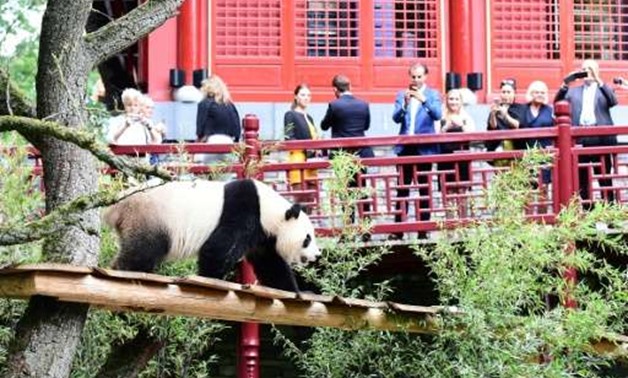
Panda fans take photos of the new panda stars making their public debut at a Dutch zoo
NETHERLANDS - 31 May 2017: Cautiously at first and then with mounting curiosity, two giant pandas stepped outside into their new open-air enclosure at a Dutch zoo on Tuesday, met by a barrage of cameras and squeals of delight.
Female Wu Wen (Beautiful Powerful Cloud) and her male companion Xing Ya (Elegant Star) were making their public debut, marking the culmination of a 16-year dream for the zoo and Dutch officials.
The pair are now going on show at Ouwehands Dierenpark zoo in central Rhenen, housed in an imposing, pagoda-style enclosure specially built at a cost of seven million euros ($7.4 million).
They arrived in The Netherlands on April 13, after an 8,000-kilometre (5,000-mile) journey from China and after years of negotiations in what has been dubbed "panda diplomacy".
But despite mounting panda-mania here the two pandas were first given a few weeks of quarantine and a chance to acclimatise to their new surroundings before going on show.
In the wild, pandas are solitary creatures and the pair are being housed separately and will be brought together when the female is on heat.
They will stay in the zoo for some 15 years, and the hope is that they will breed and help replenish global panda numbers.
While pandas remain endangered, conservation work and an increased awareness of their plight has led to a rise in numbers.
Some 1,864 pandas remain in the wild in China, an increase from around 1,000 in the late 1970s, according to the environmental group WWF.
And just over 400 pandas live in zoos around the world, in conservation projects set up with Beijing.
Zoo owner Marcel Boekhoorn said Wu Wen and Xing Ya were more than "just two impressive giants."
"Xing Ya and Wu Wen show us the power and vulnerability of our planet. Black and white. Yin and Yang," he told an invited audience at the official opening of the panda enclosure which included Chinese ambassador Wu Ken.
The "soft power" of the pandas should inspire everyone to "search for balance. Balance between countries, balance within nature. And last but not least, balance between human and animal."
The new panda enclosure is part of a larger project which also houses other Asian species. It covers about 9,000 square metres (97,000 square feet), of which 3,400 square metres are designated for the giant panda enclosure.
The pandas' area includes separate indoor and outdoor spaces, night accommodation, a nursery, a cold store for their bamboo food supply, a special veterinary clinic and an area for their full-time keepers.
The Dutch are paying a million dollars a year to Beijing for being able to house the pandas, of which some 80 percent is being ploughed back into conservation work in China, said Christian van der Hoeven, a panda expert with WWF.
"We don't get involved with zoos normally," he told AFP, while the male panda padded curiously around his enclosure behind him, and chewed enthusiastically on some bamboo.
"Almost all giant pandas are in a lease programmes, so they pay money to the Chinese government. It used to be 30 or 40 years ago, the WWF who paid the money to protect the pandas in the wild.
"Now, more and more the Chinese government is taking over these costs. So these pandas here, and in other countries, are paying for the work WWF normally did."

Comments
Leave a Comment